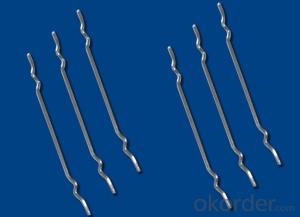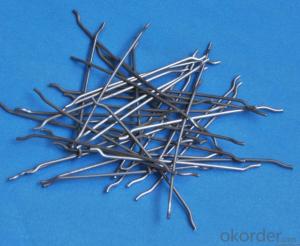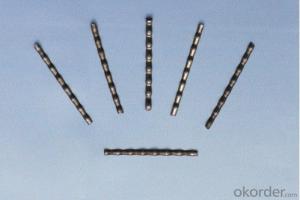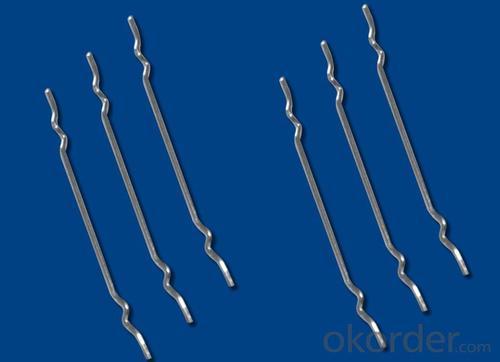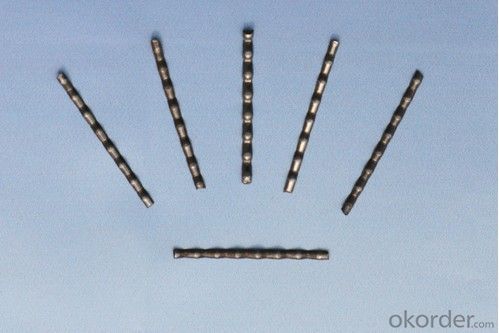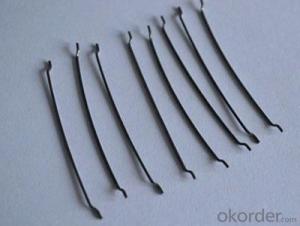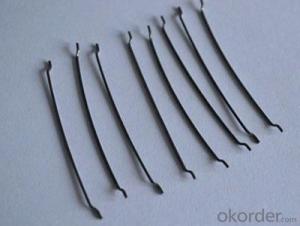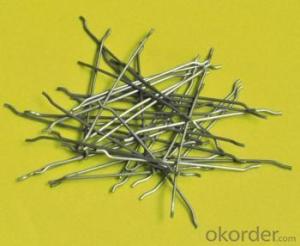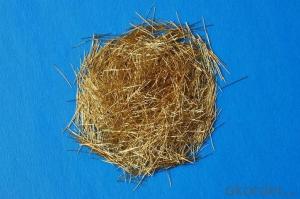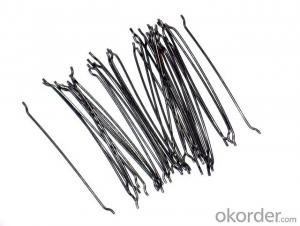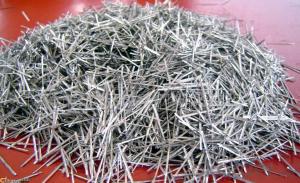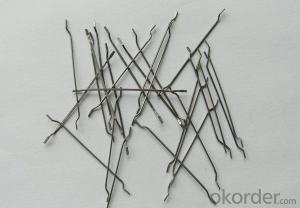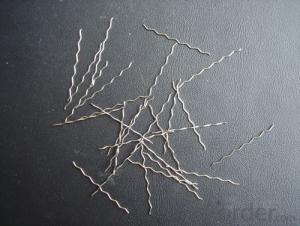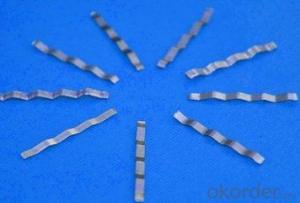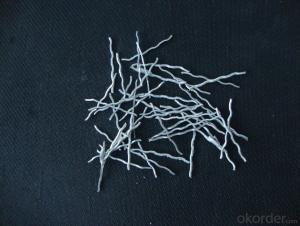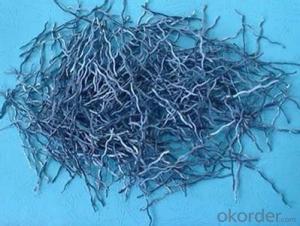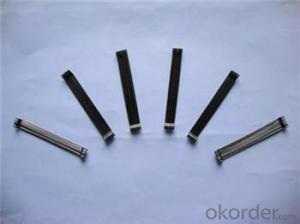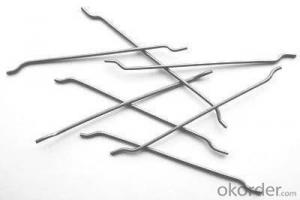Melt Extract Stainless Steel Fiber Loose End Hook for Construction
- Loading Port:
- Tianjin
- Payment Terms:
- TT OR LC
- Min Order Qty:
- 1000 kg
- Supply Capability:
- 30000 kg/month
OKorder Service Pledge
OKorder Financial Service
You Might Also Like
Quick Details
Place of Origin: China (Mainland)
Model Number: HT-MC
Material: Color Steel
certificated: ISO 9001
The Products
Our products have steady quality performance, artistic appearance. Its tensile strength, bend ductility, fatigue resistance all reach
or exceed the standerd of country's stipulation.
Our main produces are RPC coppercoated steel fiber, steel belt cuuting steel fiber and steel wire cutting steel fiber. Anual output is
15000 tons.Our raw materials are purchasing from famouse brand company in demestic.
Our products are widely used in expressway, high speed railway, industrial terrace, tunnel, bridge, airport runway and so on.We have
sold our steel fiber to lots of province of China and a lot of countrys and areas, such as korea, japan, austrilia mid-east, south asia
and so on.
1. Directadding steel fibers to the belt,the rows of steel fiber as a whole,each of the concrete uniformly dispersed Corner
2. A water-soluble glue starts to dissolve,in a row of steel fibers in a dispersion premise,dispersed again in every corner of the monofilament fiber,showing a perspective view in the concrete of the fiber web, which play the role of an overall reinforcement.
3. Compare to the monofilament fiber,the glued steel fiber wouldn't be tied up,to ensure that the fibers in the concrete mixing does not agglomerate,distributed evenly.
Specifications
model
| length(mm) | diameter(mm) | L/D
| Tensile strength | The number of per kg |
Boen-Cp 65/35 | 35 | 0.55 | 65 | ≥1100 | 14500 |
Boen-Cp 80/50 | 50 | 0.62 | 80 | ≥1100 | 8100 |
Boen-Cp 100/60 | 60 | 0.62 | 100 | ≥1100 | 6800 |
Boen-Cp 80/60 | 60 | 0.75 | 80 | ≥1100 | 4600 |
Boen-Cp 65/60 | 60 | 0.90 | 65 | ≥1000 | 3200 |
Boen-Cp 55/60 | 60 | 1.05 | 55 | ≥1000 | 2300 |
Picture
PP bag
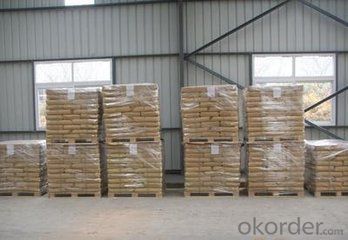
any type
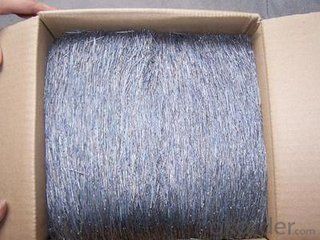
steel fiber
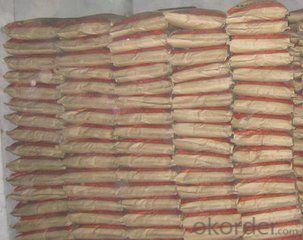
FAQ
Steel fiber
1) greatly improve concrete bonding and tensile strength
(2) improve mechanical performance concrete
(3) prevent the damage to the concrete
(4) decrease the danger from crack of the concrete
(5) provide exceptional load stability and durability
- Q: Can melt extract stainless steel fiber be used in self-compacting concrete mixtures?
- Indeed, self-compacting concrete mixtures can make use of melt extract stainless steel fiber. The inclusion of stainless steel fibers in self-compacting concrete (SCC) offers several advantages, such as enhanced mechanical properties, improved durability, and increased resistance to cracking. Melt extract stainless steel fiber possesses distinctive characteristics, including high tensile strength and resistance to corrosion, making it an ideal selection for reinforcing SCC. SCC is recognized for its capacity to effortlessly flow and fill even intricate and congested formwork without requiring vibration. Nonetheless, its flowability can occasionally result in reduced strength and heightened shrinkage. By incorporating melt extract stainless steel fibers into the SCC mixture, these concerns can be addressed. The fibers function as reinforcement, enhancing overall strength and resistance to cracking. Additionally, the fibers aid in controlling shrinkage, diminishing the likelihood of early-age and long-term cracking. Typically, melt extract stainless steel fibers are added to SCC mixtures in small amounts, typically ranging from 0.5% to 2% in volume. The precise dosage will be contingent upon the specific project requirements and the desired concrete properties. It is crucial to meticulously incorporate the fibers into the concrete, ensuring their uniform distribution throughout the mixture. In summary, melt extract stainless steel fiber is a suitable option for reinforcing self-compacting concrete mixtures. Its distinctive properties contribute to improved mechanical performance, enhanced durability, and increased resistance to cracking, thereby making it an excellent choice for various construction applications.
- Q: What is the recommended fiber content when using melt extract stainless steel fiber in concrete?
- Typically, the fiber content of melt extract stainless steel fiber in concrete is advised to be between 1% and 3% by volume. This range is deemed ideal for attaining the desired reinforcement and performance qualities in the concrete. Nevertheless, it is worth mentioning that the precise fiber content may differ depending on various factors, including the particular application, design specifications, and desired concrete properties. As a result, it is advisable to seek guidance from a qualified engineer or supplier to ascertain the suitable fiber content for a specific project.
- Q: Can melt extract stainless steel fiber be used in fiber-reinforced polymers?
- Yes, melt extract stainless steel fiber can be used in fiber-reinforced polymers (FRPs). Stainless steel fibers are often added to polymer matrices to enhance their mechanical properties such as tensile strength, flexural strength, and impact resistance. The melt extract stainless steel fibers are obtained through a specialized process that ensures uniformity and high quality. The addition of stainless steel fibers to FRPs can provide several benefits. Firstly, the fibers can enhance the overall strength and durability of the composite material, making it suitable for applications that require high strength-to-weight ratio. Secondly, stainless steel fibers can improve the fracture toughness of the FRPs, making them more resistant to crack propagation. This can be particularly important in applications where impact resistance is crucial. Additionally, the corrosion resistance of stainless steel fibers can be advantageous in environments where the FRPs may be exposed to harsh conditions, such as moisture, chemicals, or high temperatures. The stainless steel fibers can prevent corrosion of the composite material, increasing its lifespan and reliability. Overall, the use of melt extract stainless steel fibers in fiber-reinforced polymers can significantly enhance the mechanical properties and durability of the composite material, making it suitable for a wide range of applications in industries such as automotive, construction, aerospace, and marine.
- Q: What is the optimal dosage of melt extract stainless steel fiber in concrete mixes?
- The optimal dosage of melt extract stainless steel fiber in concrete mixes depends on various factors such as the specific application, desired performance characteristics, and the type of concrete being used. It is recommended to consult with a structural engineer or concrete expert to determine the appropriate dosage for a specific project.
- Q: Can melt extract stainless steel fiber be used in industrial flooring applications?
- Indeed, melt extract stainless steel fiber finds utility in the realm of industrial flooring applications. This particular fiber variety is renowned for its commendable robustness and endurance, attributes of utmost importance when it comes to flooring in industrial environments. Its capacity to endure substantial loads, impacts, and abrasions renders it apt for spaces that witness heavy pedestrian traffic or house machinery. Moreover, stainless steel fibers possess a resistance to corrosion and chemicals, guaranteeing a prolonged lifespan for the flooring material. Incorporating these fibers into concrete or alternative flooring substances is a simple task that elevates their potency and efficacy. All in all, melt extract stainless steel fiber emerges as a trustworthy option for industrial flooring applications.
- Q: Can melt extract stainless steel fiber be used in structural repair applications?
- Certainly! Melt extract stainless steel fiber is a viable option for structural repair tasks. This particular fiber is obtained by melting stainless steel and quickly extracting it into filaments, creating a robust and long-lasting material. Because of its exceptional strength and resistance to corrosion, melt extract stainless steel fiber is frequently utilized in the repair and reinforcement of concrete structures. It can be incorporated into the concrete mixture to bolster its structural integrity, improve its durability, and prevent the occurrence of cracks. Additionally, this fiber can be employed to mend damaged structures by introducing it into the repair mortar or concrete, which enhances the strength of the repaired section. Overall, melt extract stainless steel fiber is a suitable choice for structural repair endeavors, thanks to its remarkable mechanical properties and ability to enhance the performance and lifespan of repaired structures.
- Q: How does the addition of melt extract stainless steel fiber affect the ductility of concrete?
- The addition of melt extract stainless steel fiber generally improves the ductility of concrete. Stainless steel fibers act as reinforcements within the concrete matrix, enhancing its ability to withstand tensile stresses. This results in a higher ductility, allowing the concrete to undergo more deformation before failure.
- Q: What is the effect of melt extract stainless steel fiber on the post-cracking behavior of concrete?
- The impact of melt extract stainless steel fiber on concrete's behavior after cracking is significant. When incorporated into concrete, stainless steel fibers act as reinforcement and enhance the material's tensile strength and ductility. This reinforcement effectively controls concrete cracking and enhances its performance under different loading conditions. The inclusion of melt extract stainless steel fibers in concrete enhances its crack-resistance and reduces the possibility of brittle failure. These fibers are typically thin and long, allowing for a more even distribution of stress throughout the concrete matrix. Consequently, the concrete can withstand higher tensile and flexural stresses without developing significant cracks. Furthermore, the use of stainless steel fibers improves concrete's behavior after cracking by reducing crack widths and increasing crack resistance. This is particularly advantageous in structures subjected to dynamic or cyclic loading, such as bridges or pavements. The steel fibers help restrict crack propagation and prevent the formation of extensive cracks, which can compromise the concrete's structural integrity and durability. Additionally, melt extract stainless steel fibers can enhance concrete's durability by minimizing the risk of corrosion. Stainless steel exhibits high resistance to corrosion, even in aggressive environments, making it an ideal reinforcement material for concrete exposed to moisture, chloride ions, or other corrosive substances. This corrosion resistance ensures the long-term performance and service life of the concrete. In conclusion, the addition of melt extract stainless steel fiber to concrete positively impacts its behavior after cracking. It enhances the material's tensile strength, ductility, crack resistance, and durability. These advantages make stainless steel fibers an excellent choice for reinforcing concrete structures, elevating their overall performance and longevity.
- Q: Can melt extract stainless steel fiber be used in architectural facades or cladding systems?
- Yes, melt extract stainless steel fiber can be used in architectural facades or cladding systems. It offers excellent strength and durability, making it suitable for enhancing the structural integrity and aesthetics of buildings. Additionally, its resistance to corrosion and weathering makes it an ideal choice for long-lasting architectural applications.
- Q: Can melt extract stainless steel fiber be used in underwater concrete applications?
- Yes, melt extract stainless steel fiber can be used in underwater concrete applications.
Send your message to us
Melt Extract Stainless Steel Fiber Loose End Hook for Construction
- Loading Port:
- Tianjin
- Payment Terms:
- TT OR LC
- Min Order Qty:
- 1000 kg
- Supply Capability:
- 30000 kg/month
OKorder Service Pledge
OKorder Financial Service
Similar products
Hot products
Hot Searches
Related keywords
